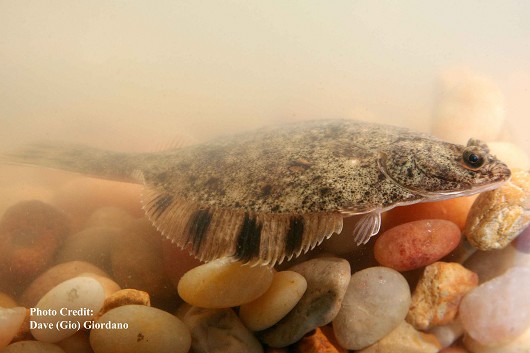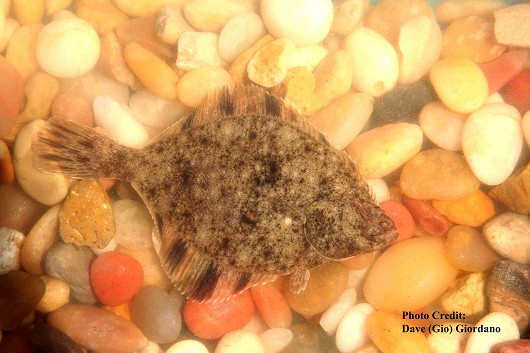Starry flounder
-
Scientific NamePlatichthys stellatus
-
NativeYes
-
Identification
 Starry flounder, juvenile, approximately 7.5 cm (3”) long. Location: Suisun Marsh, California. Date: 8/8/2007.
Starry flounder, juvenile, approximately 7.5 cm (3”) long. Location: Suisun Marsh, California. Date: 8/8/2007. Starry flounder, juvenile, approximately 7.5 cm (3”) long, dorsal view. Location: Suisun Marsh, California. Date: 8/8/2007.
Starry flounder, juvenile, approximately 7.5 cm (3”) long, dorsal view. Location: Suisun Marsh, California. Date: 8/8/2007.- Flat, laterally compressed body, adults up to 60 cm TL
- Normal “sides” become top and bottom, both eyes on one side of the head, twisted jaws
- Single pectoral fin in middle of top side, pectoral fins behind operculum, anal and dorsal fins extend along sides of body
- Star shaped plates give rough feel
- White underside, dorsal and anal fins have white to orange and black bands
- Fin rays: dorsal 52-64,anal 38-47, pectoral 10
-
Life History
Starry flounders are typically found in the ocean or in an estuary, though they have been found in freshwater streams as far as 120 km from the ocean. When flounders are in freshwater they are primarily found in low gradient rivers with soft bottoms. Usually their presence in freshwater is a result of strong ocean currents carrying the fish into an estuary. Juvenile fish may move up into a stream during high stream flow to take advantage of low salinities and abundant food sources. Extremely dry years may result in smaller freshwater populations, though the flounders will be found even further from the ocean. Young fish are generally found farther upstream than older fish as their preference for saltwater grows with age. In spring young-of-the-year flounders may be found in waters with salinities less than 2 ppt, but by summer time they are found in waters with a salinity ranging from 10-15 ppt. Temperature may also play a factor in their distribution. The feeding habits of starry flounders change as they develop and mature. Young flounders eat planktonic organisms from the water as they move. They are capable of speed bursts but generally swim by floating along the bottom. Flounders undergo a metamorphosis which transforms them into a fish well suited for bottom life. The morphed juveniles wait in the soft bottom and wait to grab prey passing overhead. They may kick up mud or sand to hide from predators. Their diet generally includes mysid shrimp, harpactacoid copepods or amphipods. In freshwater they tend to feed on insect larvae found in soft substrate. Large flounders found in freshwater are believed to be visitors, and they have to adapt as their digestion rates decrease in freshwater. Large ocean going flounders eat crabs, polychaete worms, and mollusks. Starry flounders become sexually mature at age 2 at a total length of around 35 cm. Male flounders are usually larger at this time and actually reach greater total lengths in what may be a 7-8 year life span. Spawning occurs between September and March along marine shores or estuary mouths. Females produce an average of 0.9 to over 11 million eggs. The eggs and resulting larvae are carried by water currents for 39-75 days before settling to the bottom of the water column. Favorable rearing conditions include warm and nearly fresh water.
-
Links to Other ResearchN / A

